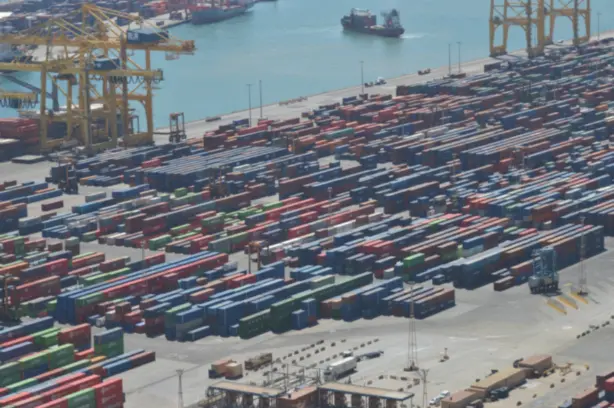By Preserve Gold Research
American investors are witnessing a mass withdrawal that echoes the darkest chapters of economic memory. In a single week, billions were yanked out of U.S. bond funds as fears crept into the market. The trigger? A growing unease that the nation could be drifting toward a dangerous crossroads: inflation rising from the ashes just as recession shadows the horizon. For many, the tremors in what were once considered the safest corners of their portfolios feel disturbingly familiar. It stirs memories of 2008—only now, the stakes may be shifting in ways we don’t yet fully grasp. The so-called “safe” assets no longer feel so safe. As investors continue to pull their money out of U.S. bond funds, many are wondering what lies ahead. Could this be the start of a new financial crisis? Will the old rules of saving for retirement still apply?
Bond Funds See Historic Outflows
A cold wind has swept through the financial markets, carrying with it a wave of unease that investors haven’t felt in years. By the second week of April, a staggering $15.64 billion had been pulled from U.S. bond funds. This marked the sharpest weekly retreat in over two years—an exodus not seen since fears over interest rates rattled markets in late 2022.
What makes this moment especially unsettling is where the panic is striking. Bonds, long considered a refuge in times of economic uncertainty, are being abandoned with unprecedented speed. Even the most established names in asset management are feeling the strain. Flagship portfolios at firms like Vanguard and BlackRock watched investors retreat, signaling a potential crisis of confidence in instruments once viewed as the backbone of financial stability.
The pullback hasn’t been contained to one corner of the bond market. Investment-grade corporate bonds, municipal bonds, even traditionally conservative loan participation funds—all saw capital drain away. According to Lipper, general taxable bond funds in the U.S. faced $6.9 billion in outflows in just one week. Investment-grade funds lost another $6.6 billion. Loan participation funds bled $6.5 billion.
Some experts warn that this isn’t just a dip. It could be the start of a broader reckoning in fixed-income markets. High-yield, or “junk,” bond funds were hit hard as well, with nearly $15.9 billion in global outflows. Even bank-loan funds, often seen as a hedge against rising rates, couldn’t escape. From April 3 to April 7, ETFs in this space lost $2.3 billion, continuing a wave of withdrawals that began weeks earlier.
When assets built to withstand volatility begin to crack, something deeper may be at work. Analysts now suggest that global bond funds as a whole experienced their worst weekly outflows in over five years. Investors aren’t just moving—they’re fleeing. And if this trend continues, it could reveal a much more fragile foundation than anyone was prepared to admit.
Inflation and Recession Fears Ignite Panic
What could spark such a dramatic retreat from bonds, normally the refuge in times of equity market chaos? The answer lies in a toxic brew of inflation worries and recession angst that has been simmering for months and just boiled over. Investors are effectively caught between the fire and the frying pan. On one hand, inflationary pressures appear to be rekindling, threatening to erode the value of bond interest payments. On the other hand, the economy’s growth engines are sputtering, raising the specter of a recession that could hit corporate earnings and employment. This one-two punch—prices that could surge even as growth stalls—is every investor’s nightmare, a scenario akin to the 1970s stagflation era many hoped was long buried in the past.
Several catalysts converged in early April to heighten these fears. Chief among them was an escalation of the U.S.–China trade war that jolted markets. In a surprise move, Washington announced sweeping new tariffs on Chinese imports in early April, significantly raising import duties. Beijing retaliated in kind with its own tariffs on U.S. goods. Overnight, the world’s two largest economies lurched toward a more intense trade confrontation, with higher barriers threatening to drive up the cost of countless products.
Investors immediately grasped the implications: tariffs often act like a tax on consumers and businesses, pushing up prices on everything from electronics to farm goods. According to Vanguard’s chief economist Joe Davis, the latest tariff salvos raised the average effective U.S. tariff rate to levels “more than a century” high. The warning was blunt. Trade walls this high could carry “significant economic ramifications,” Davis cautioned, capturing the nervous pulse of Wall Street. “We are dancing with recession.”
As trade frictions have deepened, fears of inflation have also begun to accelerate. Tariffs not only drive up prices directly, but could also ripple through the economy in subtler, more dangerous ways. Companies facing surging input costs might pass them on to consumers. Workers, stretched thin by rising living expenses, could demand higher wages. Disrupted supply chains may amplify these pressures further. It’s a chain reaction that, once triggered, is often difficult to stop.
Even the Federal Reserve has grown uneasy. Thomas Barkin, President of the Richmond Fed, admitted he was “nervous on both” inflation and employment, worried that tariffs would push up prices even as they potentially hurt the job market. It’s a delicate tightrope: too much inflation could compel the Fed to jack up interest rates even further, while a weakening economy might call for rate cuts. Policymakers are essentially stuck, forced to wait and watch a very uncertain situation. “There’s a lot of uncertainty right now,” Barkin said, “and I think this gives us reason to wait and see.”
On the ground, anxiety has also depended on the International Monetary Fund (IMF) noting a steep decline in consumer and business confidence. In late March, Managing Director Kristalina Georgieva warned that the longer the uncertainty persists, “the greater the risk to the outlook.” Recent sentiment data confirms that the IMF’s concerns are founded: households are pulling back, businesses are delaying decisions, and optimism is slipping away.
This crisis of confidence isn’t just psychological, it has material consequences. According to Goldman Sachs, the odds of a U.S. recession have jumped to 45%, up from 20% just weeks earlier. The catalyst? A sharp downturn in sentiment and growing signals from Washington that some economic sacrifice may be tolerated in the name of policy. For many, especially those who remember the painful downturns of the past, that possibility is more than troubling—it’s chilling.
Markets Flash Recession Warnings
Markets are no longer whispering—they’re shouting, and for those paying attention, the signals have become impossible to ignore. Financial markets, often seen as early indicators of economic direction, now appear to be flashing stark warnings of what could lie ahead. Nowhere is this more evident than in the bond market. In early April, the yield on the benchmark 10-year U.S. Treasury spiked to 4.45%, a surge of nearly half a percentage point in just a few days. It was the steepest weekly climb in yields since 2001. Normally, such an aggressive jump would be rare in a climate thick with recession anxiety. But experts say this isn’t a normal moment.

Yields rising so sharply could reflect a much deeper problem. Bond prices fall when yields rise, and right now, Treasuries—the world’s gold standard for safety—are being dumped. During past periods of market panic, such as in 2008 or the onset of the COVID-19 crisis, investors rushed into government bonds. This time, they’re rushing out. Some analysts fear this shift may suggest a loss of faith in U.S. fiscal credibility. Doubts are creeping in, not just about inflation, but about America’s long-assumed financial dominance. Geopolitical tensions are only amplifying the sense that something fundamental may be shifting beneath our feet.
Equity markets aren’t offering any solace. The S&P 500 and other major indices have dropped close to 10% from their February highs, reversing what had been a steady climb just weeks prior. The mood has soured quickly, and volatility has returned in full force, with the Dow whipsawing by hundreds of points in a single day. Every new data point—whether it’s a rise in jobless claims or a gloomy corporate earnings forecast—is fueling speculation that either inflation may spiral further or that growth could stall altogether. Investors have been forced into a corner, where every possible path appears fraught with risk.
Meanwhile, gold has not so quietly begun to attract inflows. For nine consecutive weeks, precious metals funds have grown, a sign that investors may be hedging against something they can’t yet fully define. When investors across asset classes begin to flee risk simultaneously, it’s often a sign of what could come next. They may be early rumbles of a downturn that has yet to fully arrive, but is drawing nearer by the day.
Experts Sound the Alarm
As troubling patterns continue to unfold, some of the most experienced voices in finance are beginning to sound the alarm. While few are willing to predict exactly what comes next, their words carry the weight of deep concern and measured urgency. Larry Fink, CEO of BlackRock—the world’s largest asset manager—has been notably candid about the precarious state of the U.S. economy.
“I’m much more worried that we could have elevated inflation that’s gonna bring rates up much higher than they are today,” he warned in early April, casting doubt on the widely held hope that the Federal Reserve might soon loosen monetary policy. In Fink’s view, there is “zero chance” the Fed will be able to cut interest rates four times this year (a wish some market bulls had clung to).
Instead, he suggests, inflation could remain stubbornly high, forcing borrowing costs to rise even further. Fink’s grim outlook is shared by many other prominent voices. In fact, he noted that most CEOs he speaks with already believe the U.S. is “very close to a recession,” if not in one already. Official narratives from the White House may still push back against that label, but market behavior—and private-sector sentiment—tell a different story.
Global institutions are voicing their own worries. The IMF recently trimmed its U.S. growth forecast for 2025 and issued a broader warning: many governments may lack the tools they once had to combat a serious downturn. Countries have used up their fiscal and monetary space during COVID and now have high debt levels, noted IMF Managing Director Kristalina Georgieva. In plain terms, central banks and treasuries could find themselves handcuffed—unable to cut rates or stimulate spending at a moment when those levers might be most needed. If inflation fails to cool, Georgieva warned, interest rates could stay elevated, making it harder for nations to refinance debt.
Vanguard’s economists, typically restrained in tone, are also turning more urgent. Their April forecast reflects a meaningful shift from earlier in the year. Accounting for tariff shocks and tightening financial conditions, Vanguard now expects U.S. GDP growth to slip below 1% in 2025—a virtual stall. Meanwhile, core inflation could hover near 4%. “The combination of stagnating activity and rising prices introduces the prospect of stagflation,” their report states, a grim scenario that could act as a “strong headwind for both stocks and bonds.”
In that environment, the Federal Reserve faces a painful paradox. As Vanguard notes, it “may be challenged to lower rates meaningfully” even as growth slows. Only if the labor market begins to fracture—pushing unemployment significantly higher—might the Fed step in to cut rates to stimulate the economy. But by then, the damage may already be done. “We’d likely already be in a painful recession,” they write. It’s the kind of lose-lose scenario that seemed far-fetched just a year ago, when inflation was fading and economic resilience was the dominant narrative.
Rising Yields and the Threat to Borrowers
For many Americans, the storm unfolding in financial markets may still seem distant—an abstract whirlwind of yields and spreads. But beneath the surface, the consequences are becoming all too real. The sharp rise in bond yields and growing unrest in credit markets are now beginning to touch everyday lives, especially for those trying to borrow money or refinance existing loans.
Take mortgage rates. After a short-lived dip below 6.5% in early April, 30-year fixed mortgage rates surged back toward 7%, closely tracking the sudden spike in Treasury yields. That figure may not sound alarming in isolation, but it’s nearly double what borrowers were paying just a few years ago. A 7% mortgage rate can transform what once seemed like an affordable home into a financial stretch. Monthly payments balloon, sidelining prospective buyers and freezing many current homeowners in place, unwilling to give up their low-rate loans for a far more expensive alternative.
The housing market, which had defied predictions of a major post-pandemic slump, could now be standing on fragile ground. If borrowing costs remain elevated, or rise further, the pressure may become too great to ignore. Refinancing activity has already dried up. Few homeowners are willing to lock into today’s rates unless absolutely necessary. And for those with variable-rate mortgages or home equity lines, monthly payments are creeping upward, month after month.
Businesses are facing similar headwinds. Companies that borrowed heavily during the era of ultra-low interest rates are now staring down a harsh reality: refinancing at far steeper rates. For mid-sized firms without deep cash reserves, higher interest expenses could force tough choices—delaying expansion, halting hiring, or initiating painful layoffs. In some cases, businesses may find themselves unable to roll over their debt at all. Defaults could follow.
Retirees’ Fraying Safety Net
For Americans approaching or already in retirement, the latest wave of financial turmoil cuts especially deep. For decades, conventional wisdom guided them to shift a greater share of their portfolios into bonds as they aged—a strategy designed to reduce risk and preserve capital. Bonds, after all, are supposed to act as a stabilizing force, delivering steady income and holding firm when stocks stumble. But that safeguard is now failing.
Today, stocks and bonds are falling together—a rare and painful alignment that leaves even the most diversified investors exposed. Traditional retirement portfolios, especially those built on the once-reliable 60/40 model, are seeing losses on both sides. It’s a disorienting moment, one that echoes the brutal memory of 2022, when inflation drove both equities and fixed income into deep declines. That year marked one of the worst stretches for retirees in recent memory, and the fear in 2025 is that we may be headed down that road again, or worse, if stagflation takes hold.
The damage is already hitting home. Retirement account statements for the first quarter of 2025 have begun arriving, and for many, they bring a jolt of anxiety. Portfolios heavy in “safe” bond funds have lost several percent in just a few short weeks. For someone no longer earning a paycheck—or planning to retire soon—the losses aren’t just uncomfortable, they’re dangerous. They represent real sacrifices: fewer years of security, scaled-back plans, and heightened uncertainty about the future.
Older investors, in particular, have limited room to maneuver. If a recession hits and layoffs rise, returning to the workforce may not be an option. Their nest eggs, already under pressure, may need to stretch further than anticipated. Meanwhile, financial advisors are fielding a surge of calls—clients asking whether they should abandon the market altogether and move to cash. But even that path carries risk. Cash may preserve nominal value, but it quietly loses purchasing power when inflation remains elevated. Bonds might recover if rates fall in a recession, but that outcome is far from guaranteed with inflation still in the picture. And the risks don’t end with individual accounts.
Many retirees rely, directly or indirectly, on pension funds and insurance providers—large institutions that manage massive pools of retirement savings. These entities are also deeply exposed to the bond market. When bond prices drop sharply and yields spike, it can throw their funding assumptions into chaos. Adjustments may follow. Some pension plans could face widening deficits, potentially threatening benefits or increasing strain on taxpayers who help fund public systems.
For retirees depending on consistent payouts, even a modest disruption can have real-world consequences. The illusion of safety has been stripped away, leaving retirees with no easy choices, only trade-offs. Each option, whether it’s staying invested, shifting to cash, or adjusting expectations, comes with its own risks. And the longer volatility and inflation persist, the harder those choices become.
Bracing for the Uncertain Road Ahead
The April surge in bond fund outflows is more than a startling data point—it may be a sign of something deeper unraveling beneath the surface of the U.S. economy. Capital doesn’t flee en masse without cause. In this case, the movement reads as a resounding vote of no confidence in the short-term outlook for financial stability and interest rate direction. Investors could be wrong. If inflation were to ease unexpectedly and the Federal Reserve responded with cuts, bonds could rebound sharply, and those who rushed for the exits might regret it. But in the current environment, few seem willing to take that chance.
Instead, the instinct to retreat is growing stronger. For many, the goal has shifted from growth to preservation—anything to avoid further loss. Some are parking cash in low-yield accounts, others are turning to gold, even physical bars, as if bracing for a prolonged siege. It’s not a strategy driven by greed. It’s one rooted in fear and doubt. Could the economy pull off a soft landing? It might. Inflation could ease, and growth could slow without stalling. But the road ahead also holds darker possibilities. Volatility may persist. A shallow recession could deepen. And while no one can say for certain what the next chapter holds, the present moment is flashing with signals that are hard to ignore.
In 2008, those who paid attention to the early tremors were better prepared when the crash came. A crisis in 2025 could be different—it could be shaped more by psychological fractures, cost pressures, and policy missteps—but it demands the same vigilance. The rush out of bonds tells us something vital: investors, from institutional giants to everyday individuals, are starting to doubt that the current economic structure will hold. If left unaddressed, that erosion of trust could accelerate, becoming self-reinforcing.







